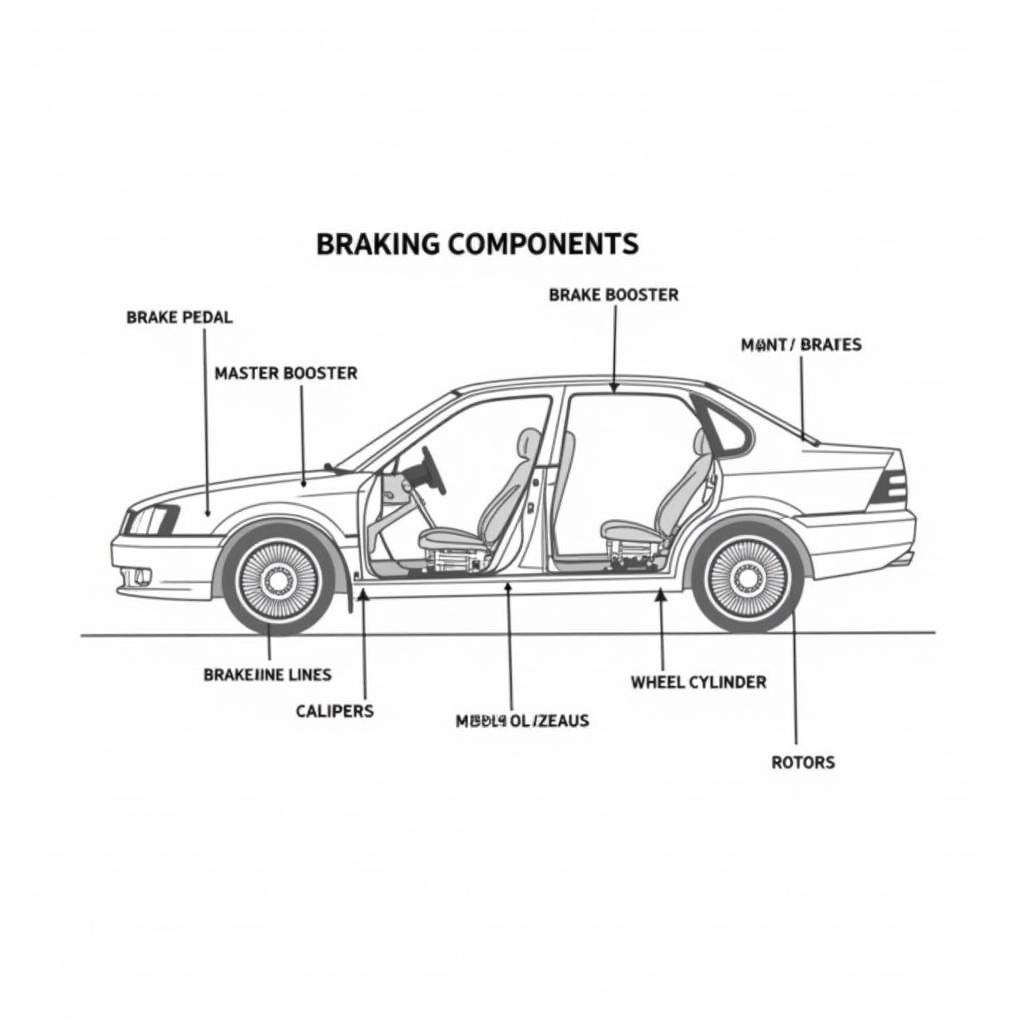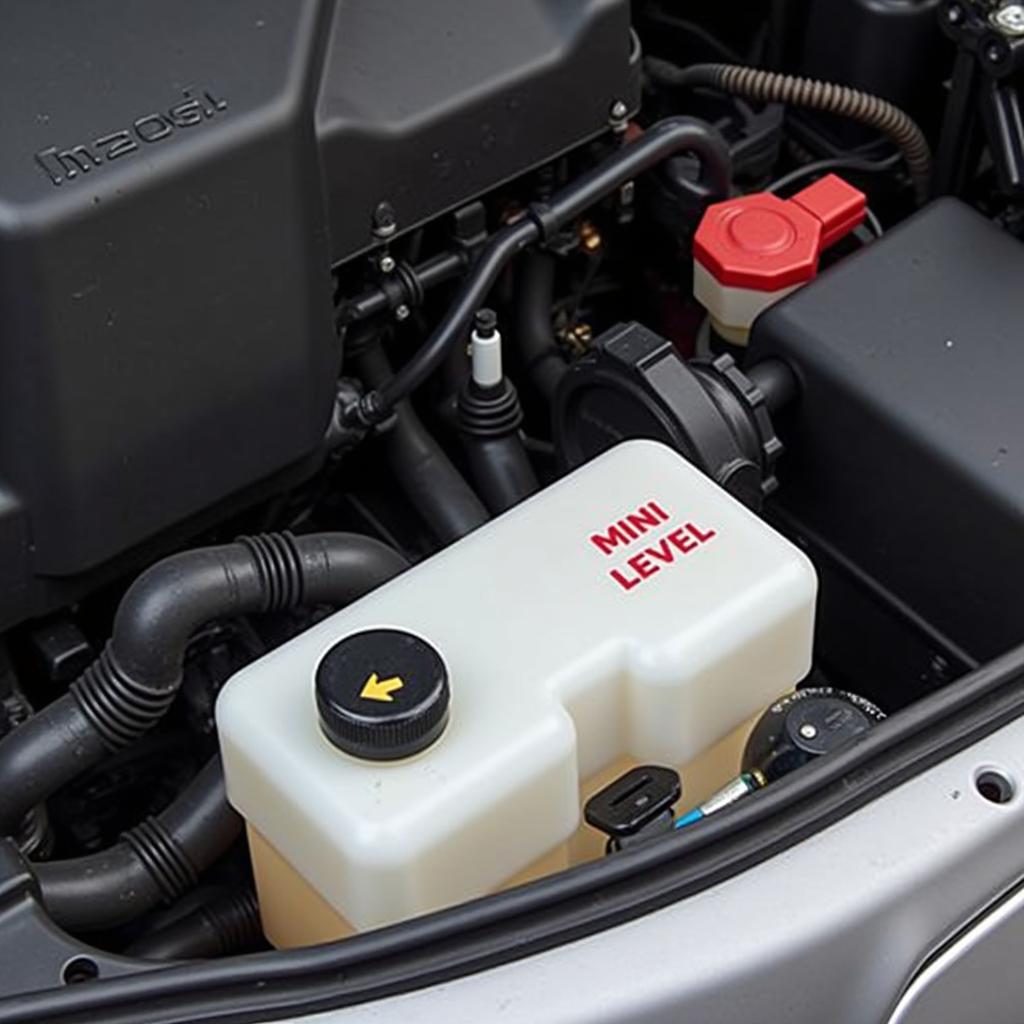A red line warning brake light illuminating on your dashboard can be a nerve-wracking experience. It’s your car’s way of screaming “Pay attention! There’s a problem with your brakes!”. Ignoring this warning is incredibly dangerous and could lead to brake failure. This article will dive into the common reasons behind a red line warning brake light, how to diagnose the problem, and the possible solutions to get you back on the road safely.
Understanding Your Car’s Braking System
Before we delve into the causes of a red line warning brake light, it’s crucial to understand the basics of how your car’s braking system works. Most modern vehicles are equipped with a hydraulic braking system composed of:
- Brake Pedal: The lever you press with your foot to slow down or stop.
- Brake Booster: This component amplifies the force you apply to the brake pedal, making braking easier.
- Master Cylinder: When you press the brake pedal, the master cylinder pushes brake fluid through the brake lines.
- Brake Lines: These carry the brake fluid to each wheel.
- Brake Calipers & Wheel Cylinders: These components use hydraulic pressure from the brake fluid to force the brake pads or brake shoes against the rotors or drums, respectively, creating friction and slowing the vehicle.
 Car brake system components diagram
Car brake system components diagram
Common Causes of a Red Line Warning Brake Light
Several issues can trigger the red line warning brake light. Here are some of the most common culprits:
1. Low Brake Fluid Level
This is often the most straightforward and easily fixable cause. Brake fluid is the lifeblood of your braking system, transmitting the force from your foot to the brakes. A leak in the system or worn-out brake pads can lead to a drop in the brake fluid level, triggering the warning light.
2. Parking Brake Engaged
It might seem obvious, but sometimes the simplest explanation is the correct one. If your parking brake, also known as the emergency brake, is even slightly engaged, it can trigger the warning light.
3. Faulty Brake Light Switch
The brake light switch is a small sensor located under your brake pedal. It signals the brake lights to illuminate when you press the brake pedal. If this switch malfunctions, it can disrupt the brake light circuit and trigger the warning light.
 Location of a car's brake light switch
Location of a car's brake light switch
4. Worn-Out Brake Pads
Brake pads are designed to wear down over time. When they become excessively thin, it can trigger a sensor that activates the red line warning brake light.
5. ABS (Anti-lock Braking System) Issue
Modern vehicles come equipped with an ABS system that prevents the wheels from locking up during hard braking, improving vehicle control. If there’s a malfunction with the ABS system, such as a faulty sensor, it can trigger the warning light.
6. Master Cylinder Failure
The master cylinder is a critical component responsible for generating the hydraulic pressure needed for braking. If it fails, you will experience a significant loss of braking power, and the warning light will likely illuminate.
How to Diagnose the Problem
If your red line warning brake light comes on, it’s crucial to diagnose the problem promptly:
- Check Your Parking Brake: Make sure your parking brake is fully disengaged.
- Inspect Brake Fluid Level: Open the hood and locate the brake fluid reservoir. Check if the fluid level is below the minimum mark.
- Visual Inspection: Look for any visible signs of brake fluid leaks around the brake lines, calipers, and master cylinder.
- Seek Professional Help: If you can’t identify the problem, or if it’s more complex than a simple brake fluid top-up, it’s best to take your vehicle to a qualified mechanic.
Resolving the Issue
The solution to your red line warning brake light will depend on the underlying cause:
- Low Brake Fluid: Top up the brake fluid to the appropriate level using the correct type of brake fluid specified in your owner’s manual.
- Worn-Out Brake Pads: Replace your brake pads with new ones. It’s recommended to replace all four brake pads at the same time.
- Faulty Components: If you’ve identified a faulty brake light switch, ABS sensor, or master cylinder, these components will need to be replaced by a qualified mechanic.
 Checking brake fluid level in a car
Checking brake fluid level in a car
Importance of Timely Repairs
Addressing any brake-related issues promptly is paramount. Ignoring a red line warning brake light could lead to:
- Complete Brake Failure: This could result in a serious accident.
- Costly Repairs: Ignoring minor issues can lead to more significant problems down the line, resulting in more expensive repairs.
- Compromised Safety: Driving with a compromised braking system puts you and other road users at risk.
Conclusion
A red line warning brake light is a serious warning that should never be ignored. By understanding the potential causes, knowing how to diagnose the issue, and taking prompt action, you can ensure your vehicle remains safe to drive. Remember, when it comes to your brakes, it’s always better to err on the side of caution and seek professional help if you’re unsure about anything. Safe driving starts with a well-maintained braking system!
FAQs
1. Can I drive with the red line warning brake light on?
It is highly discouraged to drive with the red line warning brake light on. It indicates a potential problem with your braking system, and continuing to drive could be dangerous.
2. How often should I check my brake fluid level?
It’s a good practice to check your brake fluid level at least once a month and more frequently if you notice any changes in your brake pedal feel.
3. How long can I drive on worn brake pads?
This depends on your driving habits and the condition of your brake pads. However, it’s crucial to have your brake pads inspected and replaced as soon as you notice any signs of wear or if the warning light illuminates.
4. How much does it cost to fix a red line warning brake light?
The cost can vary greatly depending on the underlying cause. A simple brake fluid top-up might cost a few dollars, while replacing a faulty master cylinder can cost several hundred dollars.
5. Can I fix a red line warning brake light myself?
If the issue is something straightforward like low brake fluid, you might be able to address it yourself. However, for more complex issues, it’s recommended to seek professional assistance from a qualified mechanic.


